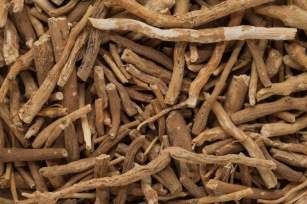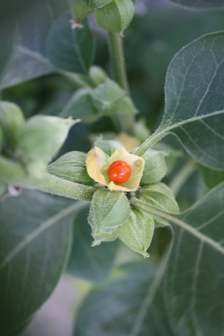Ashwagandha
Common Names: Ashwagandha, indian ginseng, poison gooseberry, winter cherry
Scientific Name: Withania somnifera
Climate: Temperate
Plant Description: It is a perennial, branched shrub with erect growth of height between 1.4 to 1.5 m. Ashwagandha leaves are dull green, ecliptic, generally up to 10-12 cm long. Each leaf grows followed by a much smaller one, and between both leaves the flowers are born in groups of 3 or 4 units. The flowers are small, yellow and bell-shaped. The fruit, in the shape of a berry and the size of a chickpea, comes out of a papery husk and when it is ripe it is red-orange.
Ashwagandha is native to India and North Africa
Cultivation: It prefers dry, sandy stony soil or light red soil with good drainage, and it likes being exposed to the full sun or a partial shade. It is a resistant plant that can withstand drought.
It can be grown from seed in the early spring, or from green wood cuttings in the late spring.
Plants generally are started from seeds in soil that is at least 21 °C. Sow in spring in earthen beds in the greenhouse or under grow lights. Saw the seeds 2 cm deep and 10 cm apart. Cover the seeds with a little compost. It needs to be kept warm, evenly moist, and in the light till the seeds germinate. The seeds take between 2 to 4 weeks to germinate. Once they have 4 true leaves prick the seedlings and move them to the containers 10-12 cm tall. After seedlings are settled, gradually begin to move them outside in the shade. When the seedlings reach a height of 10 to 15 cm, they can be planted in the ground leaving 50-60 cm of distance between the plants. Plant ashwagandha in a dry, sunny spot in well-drained, sandy soil. If the soil is poor, weeds and debris must be removed from the planting site and the compost should be added to enrich it. For optimal growth plants need temperatures between 21 °C and 35 °C.1
Ashwagandha does not tolerate excessive watering. Light watering should be provided at the time of transplant to ensure better establishment of seedlings in the soil. For best root performance, irrigate the crop once in an 8-10 days interval.
Dried leaves and red and orange berries indicate maturity and harvest time. The crop will be ready for harvest 150-180 days after planting. If harvested for roots the whole plant should be uprooted. To do this, the soil must be moistened at the time of excavation. The roots are dug or plowed using a motor hoe or a field plow. The taproot must be carefully removed without damaging even the small lateral roots.
Post-harvest management: The roots are separated from the aerial portion by cutting the stem 1 to 2 cm above the ground. After digging, the roots are washed, cut into small pieces of 7 to 10 cm and dried in the sun or in the shed. The roots should be dried with a moisture content of 10 to 12%.2 Uses: Leaves, flowers and roots are used for medicinal purposes.
Uses: Leaves, flowers and roots are used for medicinal purposes.
Leaves: The pain relieving and antioxidant properties of ashwagandha leaves are used to treat a viral infection, cough and cold symptoms, fever and chronic pain.
The flowers have powerful diuretic and aphrodisiac properties that are used to improve fertility and treat kidney problems like kidney stones.
The seeds have anthelmintic properties and are used to prevent and treat infectious diseases and parasitic invasions.
Roots: roots are the most crucial part of the plant and are mainly used in various formulations. The root has powerful aphrodisiac, diuretic, anthelmintic, antioxidant, antidepressant, antidiabetic properties and is therefore used to treat neural problems, diabetes, constipation, infertility, and skin disorders.
The leaves are used to heal ulcers of various types. For this, water should be heated with a handful of leaves and boiled for 5 minutes. Cool it down and strain the remains of the leaves. Drink tea before meals.
To improve eyesight, a juice is prepared with the root of the plant and mixed with honey. Then it is put over the eyes.
To help with sleep and as a sedative: boil water with the roots, allow to cool and take as tea before sleeping. The traditional use of ashwagandha in India, is in powder mixed with hot milk and honey, and taken before bedtime to promote healthy sleep patterns, enhance reproductive system and provide strength. A general dose can be 1/4 to 1/2 teaspoon once or twice a day.
It can lead to health problems if not used correctly.
Pests and Diseases: Common pests and diseases found are aphids, mites and insect attack, seedling rot and the pest. There are no serious pests. Selecting disease-free seeds and treating seeds before sowing is essential to reduce incidents.
References:
-
https://plantatuhuerto.com/como-cultivar-ashwagandha-cultivo-y-crecimiento-de-la-ashwagandha/
-
https://docs.google.com/document/d/1LfGzmgr-uq-ku5ep6VwMPJVOv1eXOJhhdYrPFdG737I/edit
En español: Ashwagandha

